Communication Strategy Gerakan Bersihkan Indonesia an Building a Public Agenda
Abstract
Air pollution causes public health problems, especially in vulnerable communities. Air pollution is also a contributor to climate change in Indonesia. To reduce air pollution and the rate of climate change, a group of civil society organizations that are members of Clean Indonesia seeks to build a public plan by using a communication strategy to influence the policies issued by the government to abandon fossil energy as the main cause of air pollution. This research is qualitative by using interviews and in-depth observations of Clean Indonesia. It is concluded that the communication strategy carried out by Bersih Indonesia to build a public agenda uses media advocacy by utilizing interpersonal and mass communication channels. The aim is to optimize persuasion and open up public space for the community. The news regarding the refusal of foreign bank financing to fund fossil energy projects indicates that the expected effect is achieved in public agenda communication. Still, the absence of regulations or policies issued by the government to reduce the use of fossil energy indicates that the effect of public agenda communication to the government has not been achieved.
References
A. Alamsyah, R. (2020). Pengenalan Social Network Analysis: Konsep dan Praktis (1st ed.). CV. Sadari.
Anam, K., M Kolopaking, L., & A Kinseng, R. (2020). The Effectiveness of Social Media Usage within Social Movement to Reject the Reclamation of the Jakarta Bay, Indonesia. Sodality: Jurnal Sosiologi Pedesaan, 8(1), 64–81. https://doi.org/10.22500/8202028955
Arif, A. (2019). Masyarakat Indonesia Paling Tidak Percaya Perubahan Iklim Ulah Manusia. Retrieved from Kompas.Id. https://www.kompas.id/baca/utama/2019/05/13/masyarakat-indonesia-paling-tidak-percaya-perubahan-iklim-ulah-manusia
BensinKita. (2021). 230 Ribu Meninggal Tiap Tahun Akibat Polusi Udara BBM Fosil di Indonesia. Retrieved from https://bensinkita.com/230-ribu-meninggal-tiap-tahun-akibat-polusi-udara-bbm-fosil-di-indonesia/2021/03/18/
Burcher, M. (n.d.). and Law Enforcement Applications for Intelligence Analysis.
Creswell, J. C. & D. (2018). Research Design Qualitative, Quantitative, and Mixed Methods Approaches. SAGE Publications.
Destrity, N. A. (2018). Petisi Online Sebagai Media Advokasi Alternatif dalam Upstream Social Marketing. Jurnal Komunikasi Global, 7(2), 148–168. https://doi.org/10.24815/jkg.v7i2.11833
HermawanKertajaya. (2003). Konsep Pemasaran dari Indonesia untuk dunia. CV Pilar Kencana.
Kiousis, S., Mitrook, M., Wu, X., & Seltzer, T. (2006). First- and second-level agenda-building and agenda-setting effects: Exploring the linkages among candidate news releases, media coverage, and public opinion during the 2002 florida gubernatorial election. International Journal of Phytoremediation, 21(1), 265–285. https://doi.org/10.1207/s1532754xjprr1803_4
Kurniawan, N., Studi, P., Ilmu, M., Falsafah, F., Peradaban, D. A. N., & Paramadina, U. (2021). Pemasaran Sosial Hulu (Upstream Social Marketing) Melalui Petisi Daring: Studi Kasus Organisasi Nirlaba pada Hutan itu Indonesia dan Gerakan Indonesia Diet Kantong Plastik.
LLOYD, J., & TOOGOOD, L. (2015). Journalism and PR;News Media and Public Relation In The Digital Age. Paper Knowledge . Toward a Media History of Documents, 1–139. https://reutersinstitute.politics.ox.ac.uk/our-research/journalism-and-pr-news-media-and-public-relations-digital-age
Luca, N. R., & Suggs, L. S. (2010). Strategies for the social marketing mix: A systematic review. Social Marketing Quarterly. 16(4), 122–149. https://doi.org/https://doi.org/10.1080/15245004.2010.522767
Maghfiroh, N., & Salampessy, Y. LA. (2018). Strategi Komunikasi Lsm Lingkungan Di Indonesia Dalam Mendorong Lahirnya Undang-Undang Perubahan Iklim. Jurnal Dakwah Risalah, 29(1), 07. https://doi.org/10.24014/jdr.v29i1.5776
Media Indonesia. (2021). Polusi Bahan Bakar Fosil Sebabkan Kematian Bayi Prematur. Retrieved from https://mediaindonesia.com/humaniora/2021/02/09/383660/
Pryke, S. (2012). Social Network Analysis in Construction. In Social Network Analysis in Construction. https://doi.org/10.1002/9781118443132
Schreier, M. (2012). Qualitative Content Analysis in Practice. In Qualitative Content Analysis in Practice.
Uma Sekaran and Roger Bougie. (2014). Research Methods for Business. In Encyclopedia of Quality of Life and Well-Being Research. 2. https://doi.org/10.1007/978-94-007-0753-5_102084
Copyright (c) 2022 Translitera : Jurnal Kajian Komunikasi dan Studi Media

This work is licensed under a Creative Commons Attribution-NonCommercial-ShareAlike 4.0 International License.
Authors who publish with this journal agree to the following terms:
- Copyright on any article is retained by the author(s).
- Author grant the journal, right of first publication with the work simultaneously licensed under a Creative Commons Attribution License that allows others to share the work with an acknowledgement of the work’s authorship and initial publication in this journal.
- Authors are able to enter into separate, additional contractual arrangements for the non-exclusive distribution of the journal’s published version of the work (e.g., post it to an institutional repository or publish it in a book), with an acknowledgement of its initial publication in this journal.
- Authors are permitted and encouraged to post their work online (e.g., in institutional repositories or on their website) prior to and during the submission process, as it can lead to productive exchanges, as well as earlier and greater citation of published work.
- The article and any associated published material is distributed under the Creative Commons Attribution-ShareAlike 4.0 International License










